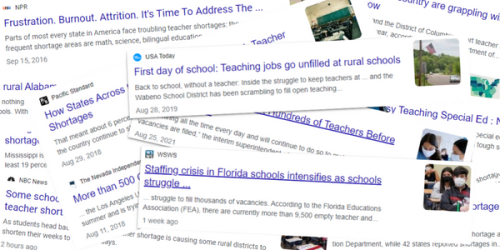One in every seven American public school children receives special education services, requiring a large teacher workforce to support this need.1 While the teacher preparation field appears to be responding, as special education is the certification area with the second-highest number of teacher preparation program completers,2 this area has been states’ most commonly cited shortage area every year dating back to the late 1990s.3
If so many special education teachers are completing preparation programs, why are special ed positions perennially so hard to staff? In this District Trendline, we examine the incentives that states and the largest school districts across the country4 offer to attract and retain special education teachers.
Before examining these policies, it is first important to understand the special education staffing landscape. Schools experience greater turnover in special education positions, with high rates of special education teachers who switch schools or leave the classroom entirely compared to their peers in other subject areas. Special education positions carry a large workload, as teachers must complete the same responsibilities as mainstream education positions, as well as added responsibilities associated with preparing Individualized Education Programs (IEPs) and holding IEP meetings, tracking and meeting legal requirements, and other demands.
For example, a study of teacher mobility in Colorado, Missouri, and South Dakota found that special education teachers were 11% more likely to leave the classroom than other teachers and 72% more likely to change schools than other teachers.5 Also, one of the strategies intended to increase the availability of special education teachers may actually backfire: a working paper recently found that teachers with dual certifications in special education and another subject (e.g., elementary education) are actually 20% less likely to accept a special education teaching position than a teacher with only a special education certification, and are also more likely to transfer from a special education to general education classroom.6
One state’s policymakers have recently taken bold action to shore up their chronic shortages of special education teachers, and it appears to be paying off. Hawaii has garnered national attention for its $10,000 pay raise for special education teachers. Comparing data from a year after the incentive began to a year before this incentive, the single-district state has seen the proportion of special ed positions that are either vacant or filled by teachers unlicensed in the field cut in half, with nearly 300 more licensed special education teachers in the state than the year before the pay increase.
While many might consider such a large salary increase extreme, research suggests that for a bonus to be effective as a retention tool, it must be sizeable: estimates range from about 7.5% of salary (roughly $5000 for the average teacher salary),7 to about 14%.8
Hawaii’s example stands out because few other states or districts have taken anywhere near such extensive measures. States’ incentives are still too rare, and while large school districts more commonly offer incentives, the amounts are usually far smaller.
How many states offer or fund incentives for special education teachers?
Most states do not provide explicit incentives for special education teachers. In fact, fewer than half of states (23 of 51—including D.C.) have any kind of policy incentivizing teachers of any shortage or high-needs subject, such as STEM, ELL, and, typically, special education (and further, only seven of these 23 states explicitly identify special education teachers as eligible for these incentives; the rest do not specify subject areas). Twelve of these 23 states offer tuition reimbursement, loan forgiveness, or stipends for teacher candidates pursuing certification in a high-needs subject area rather than increased pay. Six of these 23 states are not currently funding the incentive program.
How many large districts offer incentives for special education teachers?
Incentives for high-need subjects are more likely to be offered by individual large school districts than by states. Nearly half of large school districts (63 districts, or 43%) in the NCTQ sample offer some kind of financial incentive specifically to special education teachers. Another 16% offer incentives to teachers in unspecified hard-to-staff or shortage subjects, which likely often includes special education, but this inclusion is not explicit. A handful of districts (9%) have vague teacher contract or board policy language indicating that the superintendent, school board, or other entity can establish some kind of incentive if needed, but provide no further details. Only a third of districts (33%) do not offer any incentives to special education teachers.
| KEY: ISD = Independent School District; PSD = Public School District; PS = Public Schools; PSS = Public School System; SD = School District |
Most commonly, these incentives take the form of a salary increase, bonus, or stipend (58% of districts). These salary increases vary in approach: Some districts grant additional years of experience (or steps) on the salary schedule. For example, Boston Public Schools‘ contract states that teachers in shortage areas can be placed on any step of the salary schedule, and Cherry Creek School District (CO) says that new teachers in hard-to-fill positions can be credited for up to 10 years. Other districts (e.g., Dayton Public Schools (OH), Douglas County School District (CO), Kanawha County Schools (WV), and School District of Philadelphia (PA)) have an entirely separate and higher salary schedule for special ed teachers or teachers of hard-to-staff subjects. Other districts offer a set increase in base pay (e.g., Albuquerque Public Schools (NM), Oklahoma City Public Schools (OK), and Omaha Public Schools (NE) all offer special education teachers 5% additional salary).
Bonuses or stipends seem to be about twice as common as salary increases, although the distinction between these types of incentives is not always clear. In six districts offering a bonus or stipend, teachers can only earn a one-time bonus (e.g., a hiring bonus or recruitment incentive), though these bonuses are sometimes spread over several years. Some of these signing bonuses are quite substantial: Knox County Schools (TN) offers a $5,000 signing bonus, while Memphis-Shelby County Schools (TN) offers special education teachers a signing bonus between $5,500 and $7,500, depending on their qualifications and positions. The other districts offer annual stipends or bonuses, a mix of both one-time and ongoing bonuses, or they do not specify the time frame.
While an average raise or bonus is difficult to calculate because many districts offer a range, the low end appears to be around $100 (in San Diego Unified School District (CA) and School District of Palm Beach County (FL)). The high end, aside from Hawaii, appears to be up to a $4,725 stipend in Mesa Public Schools (AZ), a stipend ranging from $1,000 to $5,000 in El Paso Independent School District (TX) and a $5,000 stipend in Aurora Public Schools (CO).
In the only large school district to offer an incentive higher than Hawaii’s, Fort Bend Independent School District (TX) pays special education “master teachers” at the district’s specific group of innovation schools a stipend of $15,000 a year and special education “mentor teachers” at these schools a stipend of $9,000 a year, though both positions come with increased responsibilities.
What other forms do incentives take?
While raises, bonuses, and stipends are by far the most common, a handful of districts (4%) offer tuition assistance or loan repayment.
| NOTE: Some districts offer multiple types of incentives, and so are counted in more than one category. |
A few districts located in cities with a high cost of living are trying to offset that cost to attract and retain much-needed special education teachers: Boston Public Schools and New York City Department of Education both offer help with housing costs. Boston allows payment for moving expenses, while New York City provides up to a $5,000 housing stipend for teachers who take special ed assignments.
Some districts seek to support special education teachers with their duties by providing them with more time: Davis School District (UT) can authorize two days of release time for special education teachers, while Prince George’s County Public Schools (MD) offers these teachers at least five days per year to work on paperwork and IEP compliance tasks.
Do all special education teachers in a district earn incentives?
In some cases, districts only offer incentives to a subset of special education teachers. Among districts that specify that special education teachers can earn incentives, a little over half (39 of 64 districts9) suggest that all special education teachers can earn incentives. Nearly a third of these districts (19 districts) only specify incentives for a subset of special education teachers (e.g., bilingual special education teachers, special education teachers with high evaluation ratings, teachers working with students diagnosed with Autism Spectrum Disorder), and another seven districts offer some incentives to all special education teachers and other incentives to a subset of teachers. Restricting incentives to only some special education teachers would, of course, limit their reach as a recruitment or retention tool.
| NOTE: This graph only includes the 63 districts that clearly identify special education teachers for incentives, as well as one district that provides vague language about the nature of its incentives but specifies that a subset of special education teachers are included. |
Special education teachers are in high demand across the country. While financial incentives are only one factor in teachers’ career decisions, they may contribute to attracting and keeping teachers in a special education role. Considering how district incentives stack up to those offered by other large districts across the country can help school districts create a recruitment and retention package that encourages licensed special education teachers to enter and stay in the classroom.
To see more details on these and other district policies, visit the Teacher Contract Database.
More like this

How are school districts using strategic pay to attract and retain teachers where they need them?
We examine if and how 148 large U.S. school districts use strategic pay to recruit and retain teachers.

Effectively evaluating special education teachers may require a different approach
A new working paper may be cause for genuine concern regarding the most widely-used evaluation instrument in the country, the Danielson Group’s Framework for Teaching.

Dueling endorsements
Some sensible solutions sometimes turn out to be counterproductive. A prime example may exist in Washington state, which recently instituted a policy requiring new special education teachers to pursue a second endorsement.
Endnotes
- National Center for Education Statistics. (2022). Students With Disabilities. Condition of Education. U.S. Department of Education, Institute of Education Sciences. Retrieved May 6, 2022.
- U.S. Department of Education, Office of Postsecondary Education. (2021). Preparing and Credentialing the Nation’s Teachers: The Secretary’s 11th Report on the Teacher Workforce. Retrieved May 6, 2022.
- McVey, K. P., & Trinidad, J. (2019). Nuance in the Noise: The Complex Reality of Teacher Shortages. Bellwether Education Partners. Retrieved May 6, 2022.
- The NCTQ sample of
districts includes 148 school districts in the United States including: the 100
largest districts in the country, the largest district in each state, and the
member districts of the Council of Great City Schools. - Espel, E. V., Meyer, S. J., & Weston-Sementelli, J. L. (2019). Factors related to teacher mobility and attrition in Colorado, Missouri, and South Dakota (REL 2019–008). Washington, DC: U.S. Department of Education, Institute of Education Sciences, National Center for Education Evaluation and Regional Assistance, Regional Educational Laboratory Central.
- Theobald, R., Goldhaber, D., Naito, N., & Stein, M. (2020). The Special Education Teacher Pipeline: Teacher Preparation, Workforce Entry, and Retention. CALDER Working Paper No. 231-0220.
- Pham, L. D., Nguyen, T.
D., & Springer, M. G. (2020). Teacher Merit Pay: A Meta-Analysis. American Educational Research Journal,
0002831220905580. - Yesilirmak, M. (2019).
Bonus pay for teachers, spatial sorting, and student achievement. European Journal of Political Economy,
59, 129-158. - One district coded as
having vague language said that the district “may opt to provide additional
pay” but limits this option to special education teachers working with
blind/visually impaired students.


